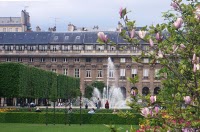The Equestrian Carrousel
 Thursday, September 30, 2010 at 10:48AM Tweet
Thursday, September 30, 2010 at 10:48AM Tweet Every Thursday I hop out of bed and head for my weekly horseback ride in the Bois de Boulogne. In so doing, I partake of a centuries-old popular French past time, desending from kings and pageantry, armed battles and plumed musketeers. In today’s class, my fellow cavaliers and I were asked to perform an equestrian carrousel, a mounted dance in which riders and horses execute precision movements in tandem, often in time with music. Curious about the history of this tradition, my friends and I interviewed our instructor after our lesson, while sipping Moet & Chandon champagne... but I’ll get back to that in a minute!
The mounted spectacle, known in French as le carrousel, seems to have come from 16th century Renaissance Italy, from the house of the Medici in Florence. It first appeared at the French court in the early 1600’s to mark royal weddings or important state visits. One famed equestrian ballet, choreographed by Louis XIII’s instructor, Antoine de Pluvinel, is still remembered and performed today. Le Carrousel du Roi debuted in 1612 to celebrate the engagement of young Louis XIII to his future wife, Anne of Austria.
The carrousel typically took place in a royal square or courtyard where elaborately costumed riders from the king’s cavalry or private guard carried out choreographed routines symbolic of the moves horsemen used in battle. Even today, in the resulting riding tradition called dressage, rider and mount approach then side step away from one another, ride in criss-crossing lines, move across the arena - as in the battlefield - nose to nose in a perfect line, and form shapes with an accuracy reflective of a well-trained mount and his even better-trained cavalier. In the days of kings, these demonstrations often took place at night, with riders carrying torches. They were almost always accompanied by the music of court composers, such as Lully.
The Place du Carrousel in front of the Louvre in Paris acquired its named when Louis XIV used it for an equestrian ballet in 1662.
Today’s Garde Républicaine, a prestigious mounted division of the French police, traces its origins back to the musketeers of Alexandre Dumas fame, the private forces employed to protect the kings, and cardinals, of France.
Garde Républicaine carrousel "La Maison Du Roi"
envoyé par LoveHorse95. - Découvrez les dernières tendances en vidéo.
Now about that champagne: Another French tradition, at least at my riding club, states that whenever a rider takes a fall, he or she is obliged to bring champagne to the next class. Hence, our morning lesson in French history accompanied by a lovely bubbly!









